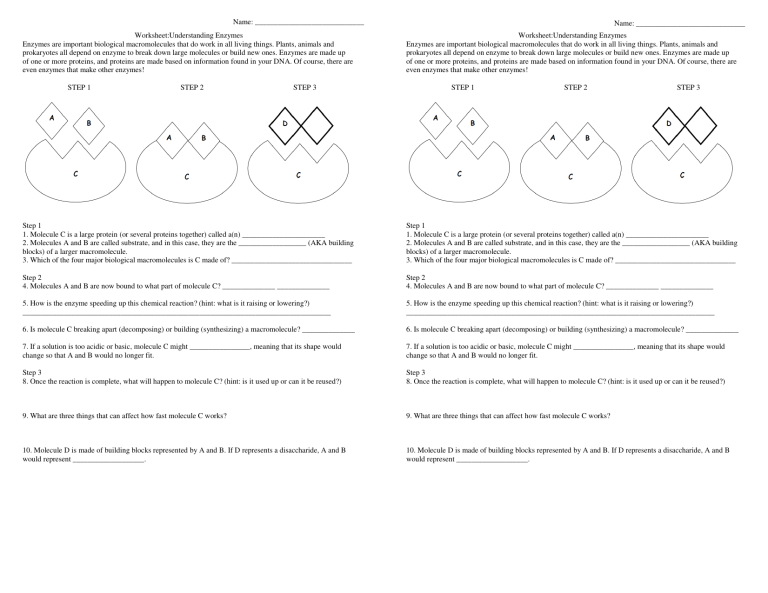Worksheet:Understanding Enzymes Enzymes are important

Name: _____________________________
Worksheet:Understanding Enzymes
Enzymes are important biological macromolecules that do work in all living things. Plants, animals and prokaryotes all depend on enzyme to break down large molecules or build new ones. Enzymes are made up of one or more proteins, and proteins are made based on information found in your DNA. Of course, there are even enzymes that make other enzymes!
STEP 1 STEP 2 STEP 3
Step 1
1. Molecule C is a large protein (or several proteins together) called a(n) ______________________
2. Molecules A and B are called substrate, and in this case, they are the __________________ (AKA building blocks) of a larger macromolecule.
3. Which of the four major biological macromolecules is C made of? ________________________________
Step 2
4. Molecules A and B are now bound to what part of molecule C? ______________ ______________
5. How is the enzyme speeding up this chemical reaction? (hint: what is it raising or lowering?)
__________________________________________________________________________________
6. Is molecule C breaking apart (decomposing) or building (synthesizing) a macromolecule? ______________
7. If a solution is too acidic or basic, molecule C might ________________, meaning that its shape would change so that A and B would no longer fit.
Step 3
8. Once the reaction is complete, what will happen to molecule C? (hint: is it used up or can it be reused?)
9. What are three things that can affect how fast molecule C works?
10. Molecule D is made of building blocks represented by A and B. If D represents a disaccharide, A and B would represent ___________________.
Name: _____________________________
Worksheet:Understanding Enzymes
Enzymes are important biological macromolecules that do work in all living things. Plants, animals and prokaryotes all depend on enzyme to break down large molecules or build new ones. Enzymes are made up of one or more proteins, and proteins are made based on information found in your DNA. Of course, there are even enzymes that make other enzymes!
STEP 1 STEP 2 STEP 3
Step 1
1. Molecule C is a large protein (or several proteins together) called a(n) ______________________
2. Molecules A and B are called substrate, and in this case, they are the __________________ (AKA building blocks) of a larger macromolecule.
3. Which of the four major biological macromolecules is C made of? ________________________________
Step 2
4. Molecules A and B are now bound to what part of molecule C? ______________ ______________
5. How is the enzyme speeding up this chemical reaction? (hint: what is it raising or lowering?)
__________________________________________________________________________________
6. Is molecule C breaking apart (decomposing) or building (synthesizing) a macromolecule? ______________
7. If a solution is too acidic or basic, molecule C might ________________, meaning that its shape would change so that A and B would no longer fit.
Step 3
8. Once the reaction is complete, what will happen to molecule C? (hint: is it used up or can it be reused?)
9. What are three things that can affect how fast molecule C works?
10. Molecule D is made of building blocks represented by A and B. If D represents a disaccharide, A and B would represent ___________________.









